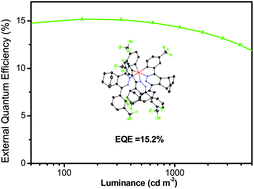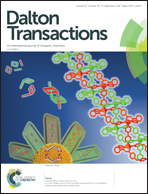High efficiency green OLEDs based on homoleptic iridium complexes with steric phenylpyridazine ligands†
Abstract
A series of steric phenylpyridazine based homoleptic iridium(III) complexes (1–3) have been synthesized with novel one-pot methods. Single X-ray structural analyses are conducted on complexes 1 and 2 to reveal their coordination arrangement. These complexes exhibit a very strong green phosphorescence emission with high quantum yields of over 64%. The relationship between photophysical properties and the substituent nature of the complexes is discussed by density functional theory (DFT) and time-dependent DFT. Self-quenching is significantly reduced for these complexes in solid even at very high concentrations because the sterically hindered bicyclo [2.2.2] oct-2-ene and m-substituted CF3 spacers in the phosphor molecules lead to minimum bimolecular interactions. Accordingly, the electroluminescence device based on complex 3 exhibits a maximum luminous efficiency of 64.1 cd A−1 with a high EQE of 25.2% at a high doping concentration of 15 wt%. Meanwhile, when neat 3 was adopted as the emitting layer, the non-doped green device gives a state-of-the-art EQE as high as 15.2% (40.1 cd A−1) along with CIE coordinates of (0.346, 0.599).



 Please wait while we load your content...
Please wait while we load your content...